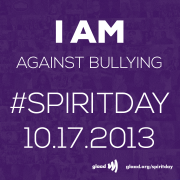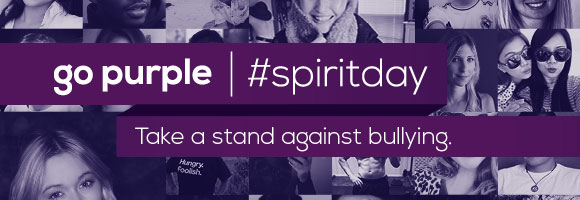Today is Wear Purple or Spirit Day remembering gay bullying and suicides since 2010 in the US. It comes after National Coming Out Day last weekend and it is a sad token of our times that it still does not feel safe for some to “come out” and instead to take their own life. This weekend the annual No to Hate candlelit vigils are held around the UK rounding off Hate Crime Awareness Week and part of the national campaign by 17-24-30 and others to remember the victims of hate crime and foster more positive attitudes towards diversities.
The first Candle-lit Vigil, attended by 10,000 people, was organised on 30th October 2009 in Trafalgar Square after the death of Ian Baynham, who died from the injuries he received when he was homophobically abused and attacked by drunken teenagers outside South Africa House.
 The Wear Purple campaign was fostered by GLAAD in 2010 after at least 5 US teen gay suicides in a just a few weeks. Tyler Clementi took his own life after being outed by his roommate. In early October 2010, Canadian teenager Brittany McMillan had promoted a new commemoration called Spirit Day after the purple “Spirit” stripe on the LGBT rainbow flag. Since then millions have taken to wearing purple on this day as members of and allies to the LGBT community and victims of homophobic and transphobic bullying.
The Wear Purple campaign was fostered by GLAAD in 2010 after at least 5 US teen gay suicides in a just a few weeks. Tyler Clementi took his own life after being outed by his roommate. In early October 2010, Canadian teenager Brittany McMillan had promoted a new commemoration called Spirit Day after the purple “Spirit” stripe on the LGBT rainbow flag. Since then millions have taken to wearing purple on this day as members of and allies to the LGBT community and victims of homophobic and transphobic bullying.
“Wearing purple on Spirit Day shows the world that not only are you a person who refuses to tolerate bullying, harassment, or hate crimes of any kind, but you are a person who supports and loves others, just as they are. You are safe to talk to, to come out to, to ask for advice or for help. Purple shows everyone you’re an ally”.
The 17-24-30 campaign remembers the 1999 London nail bomb attacks by David Copeland, killing 3 and injuring over 140 people, in Brick Lane, Brixton and Soho’s coloured and LGBT communities – even in the latter the indiscriminate nature of these heinous attacks was such that a straight woman and her unborn child were the main victims.
Copeland was a neo-Nazi ex-BNP and National Socialist Movement (an offshoot of Combat 18) organiser with subsequently recognised paranoid schizophrenia yet insufficient to justify “diminished responsibility”. His social background seems more to blame. A late developer with insecurities about his sexuality, orientation and manhood who struggled with employment and blamed immigration. He told police, “My main intent was to spread fear, resentment and hatred throughout this country, it was to cause a racial war.”
In contrast to Copeland’s aims, Britain’s communities came together over the incidents, Londoners rallying round. Surgeons worked non-stop for 72hrs and worked overtime till 11pm each night for a month to deal with the injuries – one victim remaining in hospital for 15 months. A lesbian firefighter on scene at both Brixton and Soho was shocked at the feeling of being targeted for her identity, saying:
“I am gay myself and I knew it was the lesbian, gay, bisexual, transsexual community that was being targeted. My partner, who I hadn’t met at the time, was working just across the road from the Admiral Duncan when the bomb went off. She said it was horrific… I found it hard to believe that someone was targeting my community in such a horrifying way. I was deeply, deeply hurt.”
A Brick Lane trader, Leo Epstein, whose shop was damaged, rushed to the scene. Copeland had planned to target the Jewish community next after Black, Asian and LGBT. Brick Lane, now predominantly Asian was previously a Jewish quarter and good relations remain between the two communities. As Epstein says:
“We all trade with open doors on Brick Lane, so on Monday morning, when they let us go back, we all stood around looking at the damage and talking about it. It was like the Blitz spirit, people were coming round and saying to me, ‘We’ve got builders in doing some work on our shop, do you need anything done?’ I’ve been here for 52 years and I know everybody, and we’re good friends. As I’m the last Jewish trader in Brick Lane, many of the Asian shop owners come in from time to time and say, ‘Oh good, you’re still here, why don’t you come and have a meal on us.’ You can’t exist if you don’t get on with everybody else“.
It is apparent that bad news sells and influences, one thing we need more of is good news, not as the endpiece 2 minute feel good soundbite cat rescue story on a local news channel – but national positive stories of diversity working, cultures being celebrated, communication and community changing lives.
Eric Robert Rudolph’s purpose behind the bombings according to his April 13, 2005 statement, “was to confound, anger and embarrass the Washington government in the eyes of the world for its abominable sanctioning of abortion on demand.” He opposed “the ideals of global socialism” and “the so-called Olympic movement”‘s promoting of it.
Back on April Fool’s Day 1973 John and Yoko invented Nutopia – a new, utopian society that, “has no land, no boundaries, no passports, only people. NUTOPIA has no laws other than cosmic.” Ten years later U2 used the all-white Nutopian flag in their live performances of their third album and tour, War.
Rolling Stone magazine described Imagine‘s lyrics as “22 lines of graceful, plain-spoken faith in the power of a world, united in purpose, to repair and change itself.” One can hope…
Imagine all the peopleLiving life in peace…You may say I’m a dreamerBut I’m not the only oneI hope someday you’ll join usAnd the world will be as one
